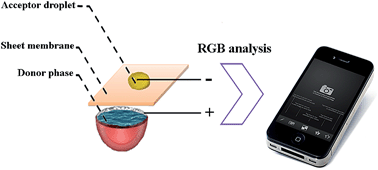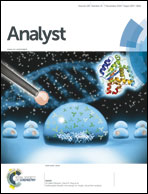Low voltage electrically stimulated lab-on-a-chip device followed by red-green-blue analysis: a simple and efficient design for complicated matrices
Abstract
In the present work, a simple and portable analysis device was designed for the first time for the determination of lead ions as the model analyte. The basis of the lead analysis is its extraction and pre-concentration in an acceptor droplet via the application of an electrical field. The acceptor droplet is a KI solution and therefore, the formation of a yellow precipitation of PbI2 was a sign of the presence of lead ion in the solution. Following this, digital picture of the final acceptor droplet was analyzed by investigating its Red-Green-Blue (RGB) components. The results show that the RGB intensities of the acceptor phase are proportionate to the lead concentration in the sample solution. Also, a 9.0 V battery was used to apply the electrical field, and other effective parameters, such as the type of organic liquid membrane, pH of the sample solution, and the extraction time, were considered to obtain the optimal conditions. The model analyte was determined by extracting it from a 100 μL sample solution across a thin layer of 1-octanol, immobilized in the pores of a polypropylene membrane sheet, and into the acceptor droplet via applying a 9.0 V electrical potential for 20 min. The device is capable of determining lead ions down to 20.0 ng mL−1, with admissible repeatability and reproducibility (the intra- and inter-assay precision ranged between 3.8–7.0% and 9.8–11.9%, respectively). Also, we calculated error% for the model analyte in the range of −8.5 to +4.5, which suggests that the chip offers acceptable accuracy for the analysis of lead ions. The linearity was studied in the range of 50.0–1500 ng mL−1, with a correlation coefficient of 0.9994. Finally, the designed device was used for the analysis of lead in real samples.


 Please wait while we load your content...
Please wait while we load your content...